Abstract
BACKGROUND: Helicobacter pylori produces large amounts of urease presumably to be prepared for the rare event of a sudden acid exposure. The hypothesis that H pylori is acid sensitive and protein production is inhibited by low pH was examined. METHODS: H pylori or its soluble enzymes were incubated buffered or unbuffered at a pH ranging from 2-7 in the presence of 5 mM urea for 30 minutes. After exposure, urease and catalase activities of whole cells, supernatants, and soluble enzyme preparations were measured at pH 6.8. Newly synthesised enzyme was quantified by immunoprecipitation of [35S]-methionine labelled protein. RESULTS: Exposure to buffer below pH 4 resulted in loss of intracellular urease activity. In soluble enzyme preparations and supernatant, no urease activity was measurable after incubation at pH < 5. In contrast, catalase in whole cells, supernatant, and soluble enzyme preparations remained active after exposure to pH > or = 3. Exposure below pH 5 inhibited synthesis of total protein including nascent urease and catalase. At pH 6 or 7, urease represented 10% of total protein, catalase 1.5%. Exposure of H pylori to unbuffered HCl (pH > 2) resulted in an immediate neutralisation; urease and catalase activities and synthesis were unchanged. CONCLUSION: Low surrounding pH reduces activity of urease and synthesis of nascent urease, catalase, and presumably of most other proteins. This suggests that H pylori is not acidophilic although it tolerates short-term exposure to low pH.
Full text
PDF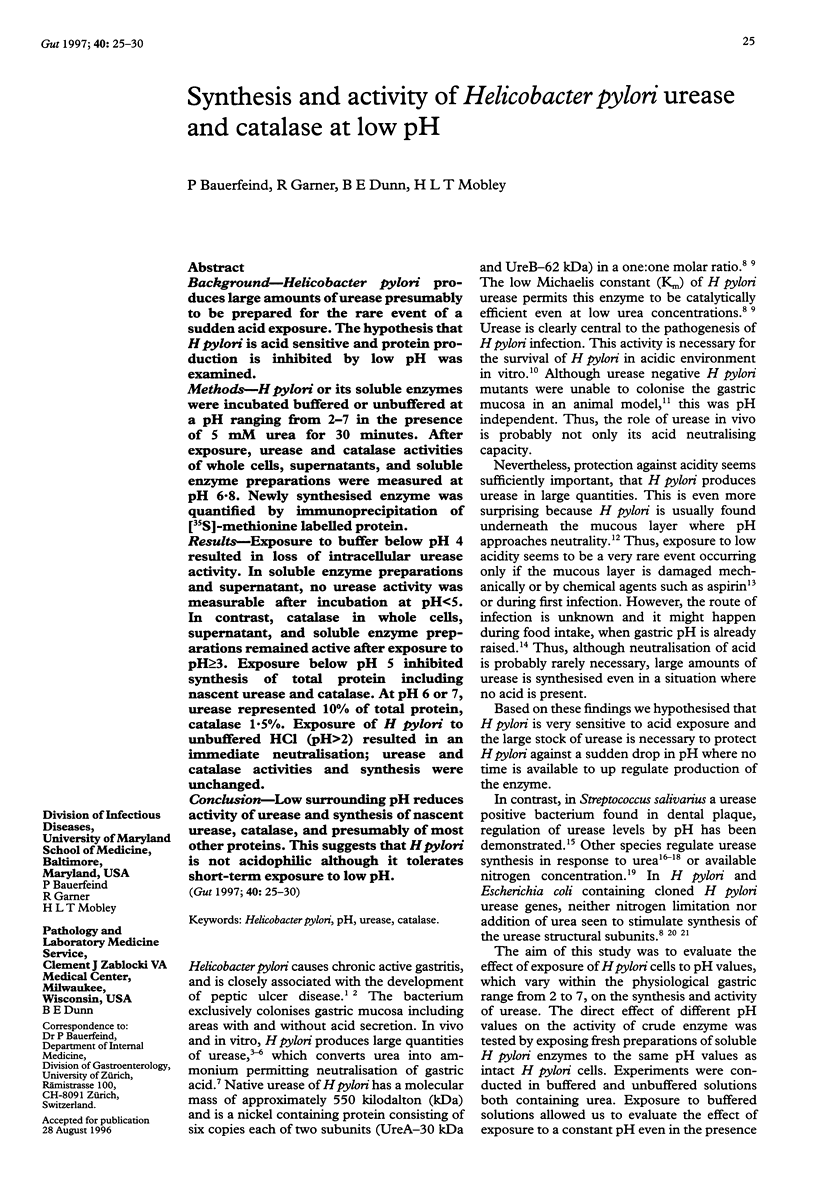
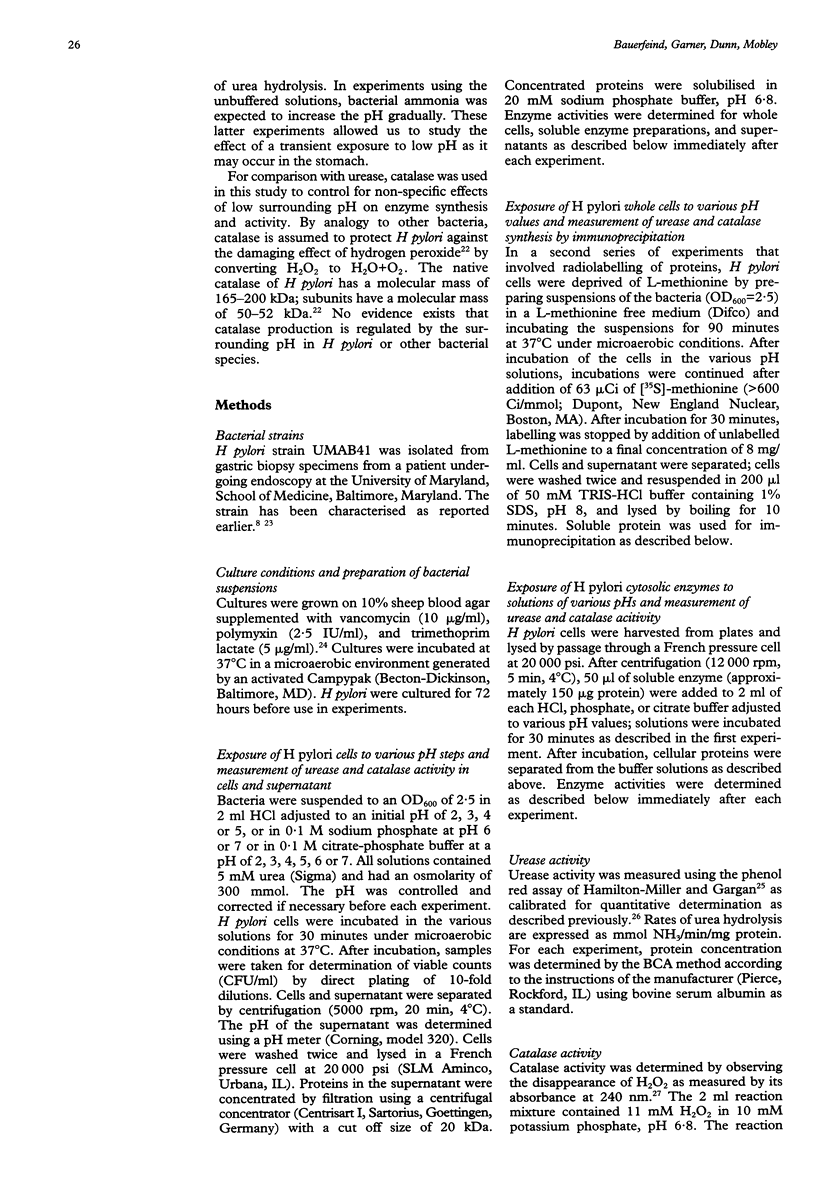
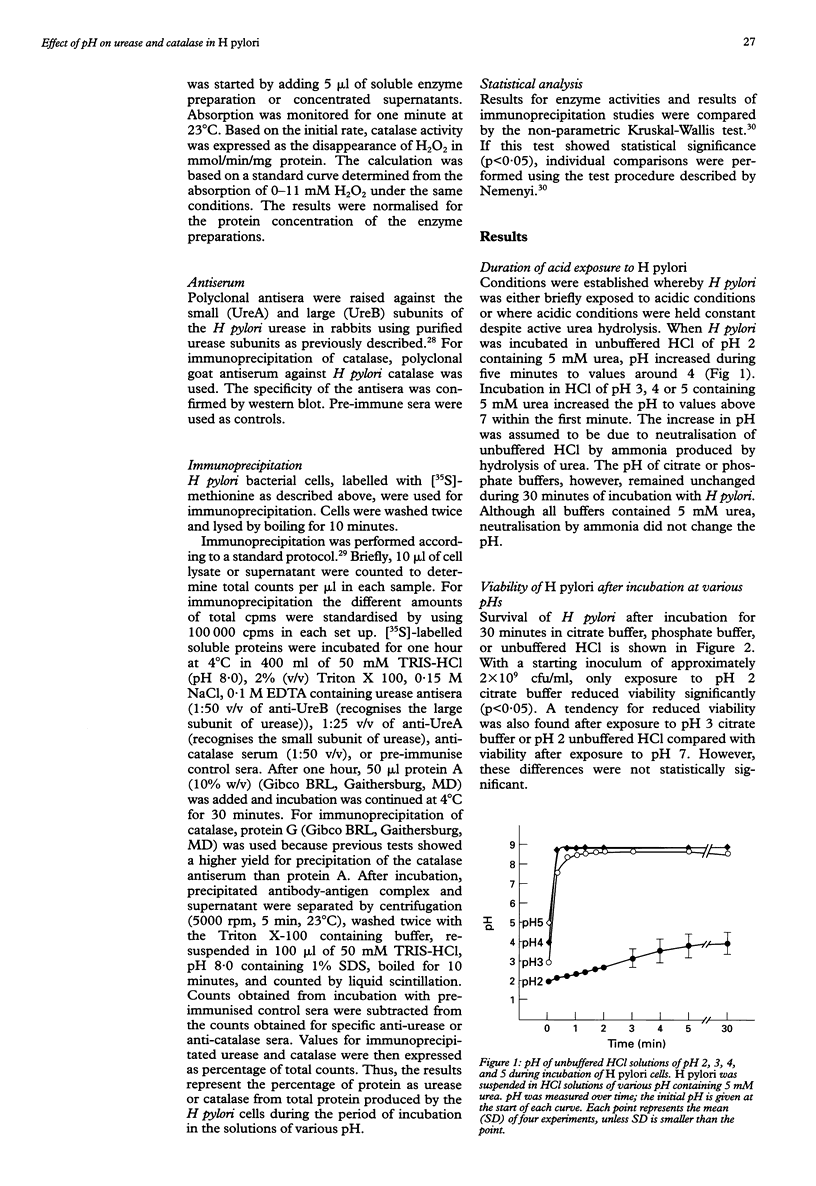
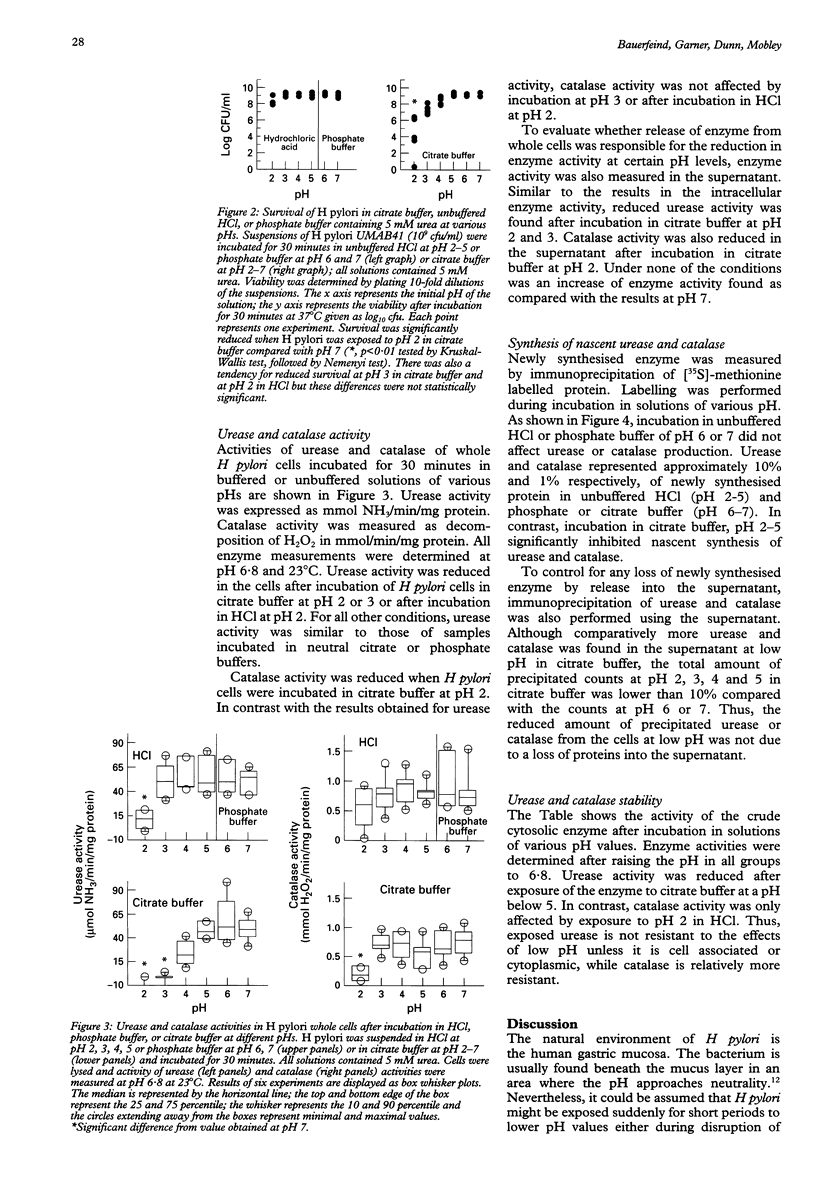
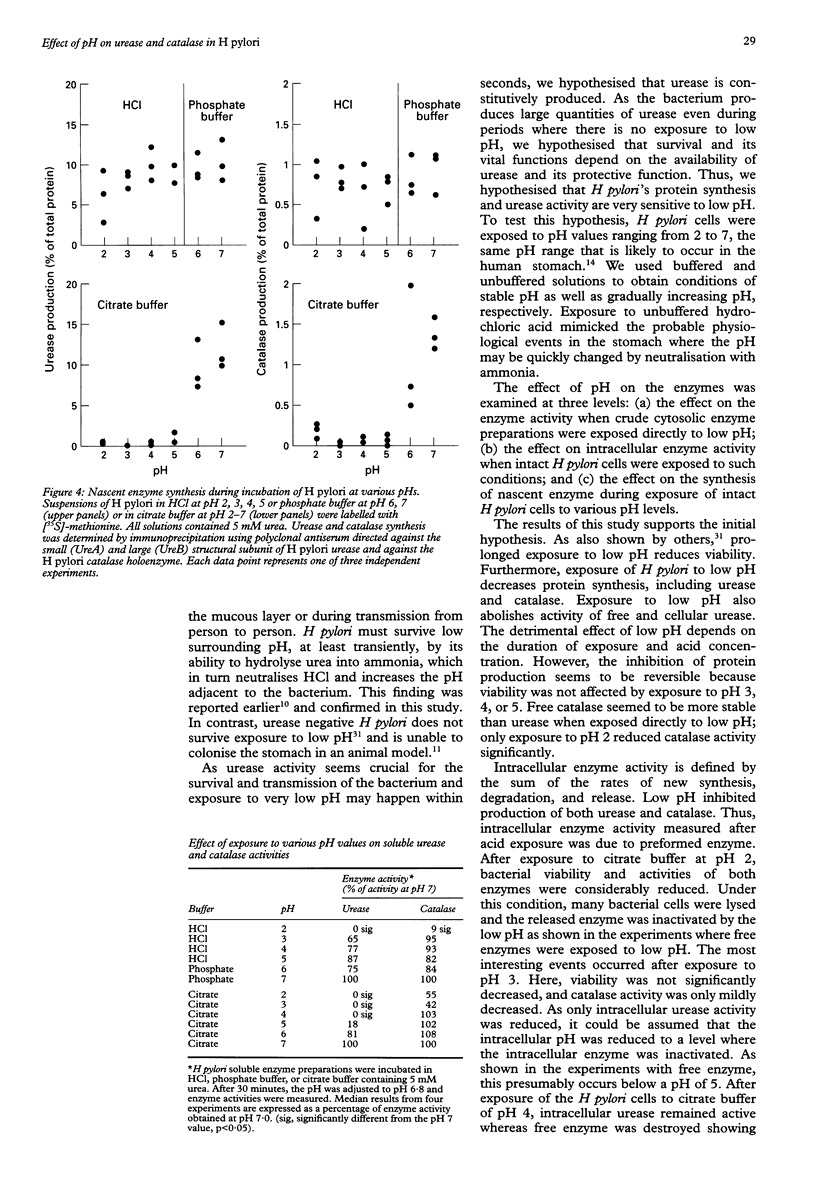
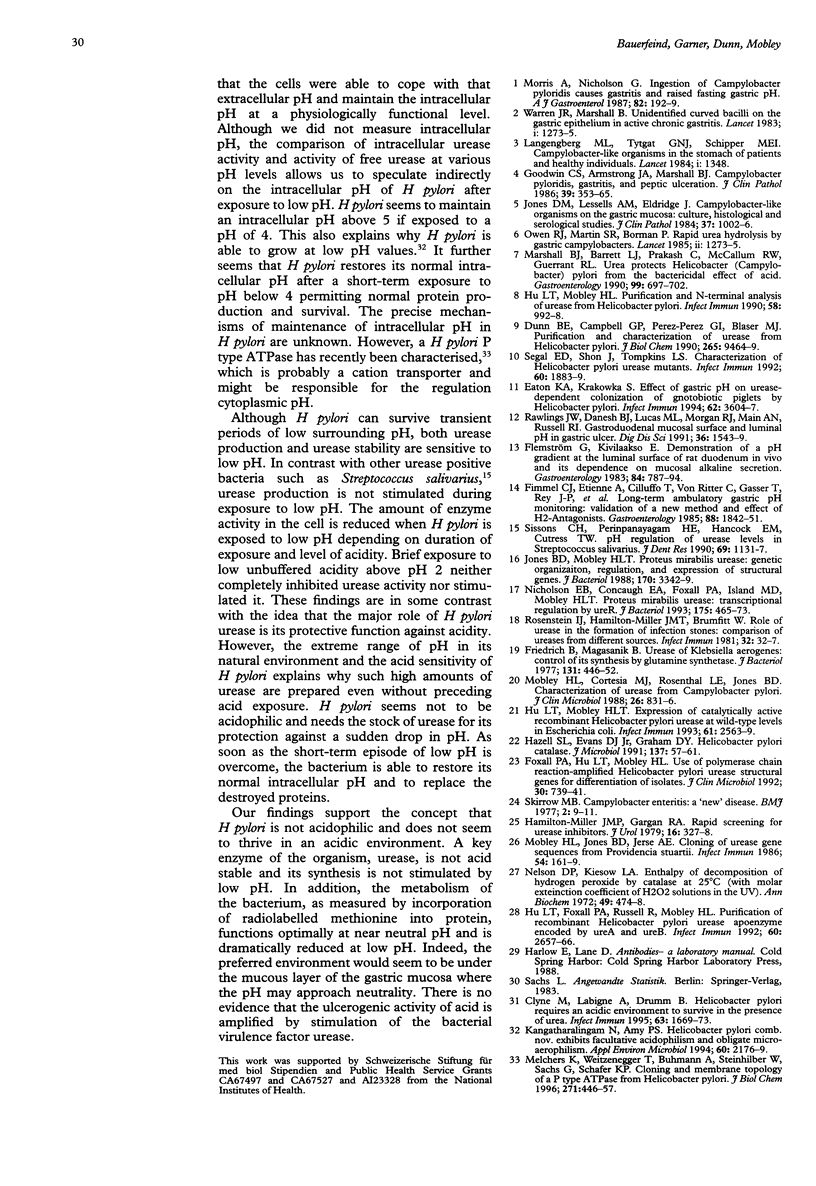
Selected References
These references are in PubMed. This may not be the complete list of references from this article.
- Campylobacter-like organisms in the stomach of patients and healthy individuals. Lancet. 1984 Jun 16;1(8390):1348–1349. [PubMed] [Google Scholar]
- Clyne M., Labigne A., Drumm B. Helicobacter pylori requires an acidic environment to survive in the presence of urea. Infect Immun. 1995 May;63(5):1669–1673. doi: 10.1128/iai.63.5.1669-1673.1995. [DOI] [PMC free article] [PubMed] [Google Scholar]
- Dunn B. E., Campbell G. P., Perez-Perez G. I., Blaser M. J. Purification and characterization of urease from Helicobacter pylori. J Biol Chem. 1990 Jun 5;265(16):9464–9469. [PubMed] [Google Scholar]
- Eaton K. A., Krakowka S. Effect of gastric pH on urease-dependent colonization of gnotobiotic piglets by Helicobacter pylori. Infect Immun. 1994 Sep;62(9):3604–3607. doi: 10.1128/iai.62.9.3604-3607.1994. [DOI] [PMC free article] [PubMed] [Google Scholar]
- Fimmel C. J., Etienne A., Cilluffo T., von Ritter C., Gasser T., Rey J. P., Caradonna-Moscatelli P., Sabbatini F., Pace F., Bühler H. W. Long-term ambulatory gastric pH monitoring: validation of a new method and effect of H2-antagonists. Gastroenterology. 1985 Jun;88(6):1842–1851. doi: 10.1016/0016-5085(85)90009-5. [DOI] [PubMed] [Google Scholar]
- Flemström G., Kivilaakso E. Demonstration of a pH gradient at the luminal surface of rat duodenum in vivo and its dependence on mucosal alkaline secretion. Gastroenterology. 1983 Apr;84(4):787–794. [PubMed] [Google Scholar]
- Flemström G., Kivilaakso E. Demonstration of a pH gradient at the luminal surface of rat duodenum in vivo and its dependence on mucosal alkaline secretion. Gastroenterology. 1983 Apr;84(4):787–794. [PubMed] [Google Scholar]
- Foxall P. A., Hu L. T., Mobley H. L. Use of polymerase chain reaction-amplified Helicobacter pylori urease structural genes for differentiation of isolates. J Clin Microbiol. 1992 Mar;30(3):739–741. doi: 10.1128/jcm.30.3.739-741.1992. [DOI] [PMC free article] [PubMed] [Google Scholar]
- Foxall P. A., Hu L. T., Mobley H. L. Use of polymerase chain reaction-amplified Helicobacter pylori urease structural genes for differentiation of isolates. J Clin Microbiol. 1992 Mar;30(3):739–741. doi: 10.1128/jcm.30.3.739-741.1992. [DOI] [PMC free article] [PubMed] [Google Scholar]
- Friedrich B., Magasanik B. Urease of Klebsiella aerogenes: control of its synthesis by glutamine synthetase. J Bacteriol. 1977 Aug;131(2):446–452. doi: 10.1128/jb.131.2.446-452.1977. [DOI] [PMC free article] [PubMed] [Google Scholar]
- Goodwin C. S., Armstrong J. A., Marshall B. J. Campylobacter pyloridis, gastritis, and peptic ulceration. J Clin Pathol. 1986 Apr;39(4):353–365. doi: 10.1136/jcp.39.4.353. [DOI] [PMC free article] [PubMed] [Google Scholar]
- Hamilton-Miller J. M., Gargan R. A. Rapid screening for urease inhibitors. Invest Urol. 1979 Mar;16(5):327–328. [PubMed] [Google Scholar]
- Hu L. T., Foxall P. A., Russell R., Mobley H. L. Purification of recombinant Helicobacter pylori urease apoenzyme encoded by ureA and ureB. Infect Immun. 1992 Jul;60(7):2657–2666. doi: 10.1128/iai.60.7.2657-2666.1992. [DOI] [PMC free article] [PubMed] [Google Scholar]
- Hu L. T., Mobley H. L. Expression of catalytically active recombinant Helicobacter pylori urease at wild-type levels in Escherichia coli. Infect Immun. 1993 Jun;61(6):2563–2569. doi: 10.1128/iai.61.6.2563-2569.1993. [DOI] [PMC free article] [PubMed] [Google Scholar]
- Hu L. T., Mobley H. L. Purification and N-terminal analysis of urease from Helicobacter pylori. Infect Immun. 1990 Apr;58(4):992–998. doi: 10.1128/iai.58.4.992-998.1990. [DOI] [PMC free article] [PubMed] [Google Scholar]
- Jones B. D., Mobley H. L. Proteus mirabilis urease: genetic organization, regulation, and expression of structural genes. J Bacteriol. 1988 Aug;170(8):3342–3349. doi: 10.1128/jb.170.8.3342-3349.1988. [DOI] [PMC free article] [PubMed] [Google Scholar]
- Jones D. M., Lessells A. M., Eldridge J. Campylobacter like organisms on the gastric mucosa: culture, histological, and serological studies. J Clin Pathol. 1984 Sep;37(9):1002–1006. doi: 10.1136/jcp.37.9.1002. [DOI] [PMC free article] [PubMed] [Google Scholar]
- Kangatharalingam N., Amy P. S. Helicobacter pylori comb. nov. Exhibits Facultative Acidophilism and Obligate Microaerophilism. Appl Environ Microbiol. 1994 Jun;60(6):2176–2179. doi: 10.1128/aem.60.6.2176-2179.1994. [DOI] [PMC free article] [PubMed] [Google Scholar]
- Marshall B. J., Barrett L. J., Prakash C., McCallum R. W., Guerrant R. L. Urea protects Helicobacter (Campylobacter) pylori from the bactericidal effect of acid. Gastroenterology. 1990 Sep;99(3):697–702. doi: 10.1016/0016-5085(90)90957-3. [DOI] [PubMed] [Google Scholar]
- Melchers K., Weitzenegger T., Buhmann A., Steinhilber W., Sachs G., Schäfer K. P. Cloning and membrane topology of a P type ATPase from Helicobacter pylori. J Biol Chem. 1996 Jan 5;271(1):446–457. doi: 10.1074/jbc.271.1.446. [DOI] [PubMed] [Google Scholar]
- Mobley H. L., Cortesia M. J., Rosenthal L. E., Jones B. D. Characterization of urease from Campylobacter pylori. J Clin Microbiol. 1988 May;26(5):831–836. doi: 10.1128/jcm.26.5.831-836.1988. [DOI] [PMC free article] [PubMed] [Google Scholar]
- Mobley H. L., Jones B. D., Jerse A. E. Cloning of urease gene sequences from Providencia stuartii. Infect Immun. 1986 Oct;54(1):161–169. doi: 10.1128/iai.54.1.161-169.1986. [DOI] [PMC free article] [PubMed] [Google Scholar]
- Morris A., Nicholson G. Ingestion of Campylobacter pyloridis causes gastritis and raised fasting gastric pH. Am J Gastroenterol. 1987 Mar;82(3):192–199. [PubMed] [Google Scholar]
- Nelson D. P., Kiesow L. A. Enthalpy of decomposition of hydrogen peroxide by catalase at 25 degrees C (with molar extinction coefficients of H 2 O 2 solutions in the UV). Anal Biochem. 1972 Oct;49(2):474–478. doi: 10.1016/0003-2697(72)90451-4. [DOI] [PubMed] [Google Scholar]
- Nicholson E. B., Concaugh E. A., Foxall P. A., Island M. D., Mobley H. L. Proteus mirabilis urease: transcriptional regulation by UreR. J Bacteriol. 1993 Jan;175(2):465–473. doi: 10.1128/jb.175.2.465-473.1993. [DOI] [PMC free article] [PubMed] [Google Scholar]
- Rawlings J. W., Danesh B. J., Lucas M. L., Morgan R. J., Main A. N., Russell R. I. Gastroduodenal mucosal surface and luminal pH in gastric ulcer. Dig Dis Sci. 1991 Nov;36(11):1543–1549. doi: 10.1007/BF01296395. [DOI] [PubMed] [Google Scholar]
- Rosenstein I. J., Hamilton-Miller J. M., Brumfitt W. Role of urease in the formation of infection stones: comparison of ureases from different sources. Infect Immun. 1981 Apr;32(1):32–37. doi: 10.1128/iai.32.1.32-37.1981. [DOI] [PMC free article] [PubMed] [Google Scholar]
- Segal E. D., Shon J., Tompkins L. S. Characterization of Helicobacter pylori urease mutants. Infect Immun. 1992 May;60(5):1883–1889. doi: 10.1128/iai.60.5.1883-1889.1992. [DOI] [PMC free article] [PubMed] [Google Scholar]
- Sissons C. H., Perinpanayagam H. E., Hancock E. M., Cutress T. W. pH regulation of urease levels in Streptococcus salivarius. J Dent Res. 1990 May;69(5):1131–1137. doi: 10.1177/00220345900690050301. [DOI] [PubMed] [Google Scholar]
- Skirrow M. B. Campylobacter enteritis: a "new" disease. Br Med J. 1977 Jul 2;2(6078):9–11. doi: 10.1136/bmj.2.6078.9. [DOI] [PMC free article] [PubMed] [Google Scholar]
- Unidentified curved bacilli on gastric epithelium in active chronic gastritis. Lancet. 1983 Jun 4;1(8336):1273–1275. [PubMed] [Google Scholar]


